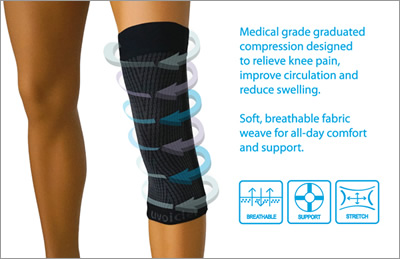Compression Knee Sleeves – Tips for Preventing Knee Pain
Why do your knees hurt?
If your knees hurt, you are not alone. Though many people associate knee pain with the kinds of knee injuries that elite professional athletes get such as blown out ACLs, MCLs, and ripped cartilage, the fact is that knee pain is a common complaint that affects people of all ages. Sure, knee pain can be the result of a sports-related injury, but even more common is the knee pain that is caused by age, weight, and medical conditions such as arthritis, gout, and infections. The good news is that most kinds of minor knee pain can be successfully managed with self-care preventative measures.
Tips for Preventing Knee Pain
Although it is not always possible to prevent knee pain from developing, the following tips will help you to avoid injuries and ward off joint deterioration:
- Maintain your weight. Make sure that you know what a healthy weight range is for age and lifestyle, and then commit to staying within that range. Every extra pound of weight that you carry strains your knees and increases the risk of injury and osteoarthritis. Maintaining an age and lifestyle appropriate weight is one of the best things you can do for your knees.
- Perfect your knee movements. Whether you are playing a sport or just casually moving about, understand the way your knee needs to flex and seek to perfect that movement. Whether doing exercises at the gym, squatting to read a green at the golf course, or bending your knees to lean over and pick up things around the house, the simple act of flexing the knees can cause pain and injury when done incorrectly. When bending your knee, a good rule of thumb for the average person to follow is to not let your knee move forward well beyond your toe. If it does, you will be placing too much weight on the knee which can stress and damage the joint.
- Increase your strength. Knee injuries are often caused by weak muscles that give way and allow your knee to get out of its correct position and alignment. Increasing the strength of the muscles on the front and back of your thighs, quadriceps and hamstrings, will help them support your knees.
- Exercise wisely. If you have knee pain, you will likely need to change the way you exercise. You should switch from high impact to low impact exercises and activities. For example, consider performing stationary lunges instead of walking lunges, or swimming instead of running. Often times, simply limiting high-impact activities will provide relief to your knees.
- RICE method for injuries. If you’ve ever hurt your knee or had another type of sprain or strain, chances are your doctor recommended rest, ice, compression, and elevation (RICE) as one of your first treatments. The RICE method is a simple self-care technique that helps reduce swelling, ease pain, and speed up healing.
- Use protective equipment. Protective equipment such as knee sleeves and knee braces provide support to your knees and protect them from further injury. Such protection is especially important for active people such as sports enthusiasts and outdoor workers whose knees are put under daily pressure from such things as running, jumping, and lifting.
What are compression knee sleeves?
Compression knee sleeves are a type of compression garment that are slipped on and worn over the knee to provide support and protection. Compression knee sleeves do not limit movement in any way and can be useful if an individual is experiencing knee pain or has had a minor injury.
What are the benefits of compression knee sleeves?
As with compression garments in general, compression knee sleeves provide many areas of benefit including comfort, performance, support, and recovery.
- Reduces inflammation and swelling. Compression knee sleeves increase blood flow to the area of the knee which reduces pain and swelling both during and after a workout or activity.
- Improves circulation for faster recovery. Both during and after your workout, compression knee sleeves improve the circulation of blood which helps your muscles to recover more quickly.
- Provides muscle stabilization. Compression knee sleeves are tight, but not too tight. They provide support to the whole knee area, stabilizing the knee joint and surrounding muscles and tendons.
- Improves self-movement of the knee. Compression knee sleeves help to ensure a proper and natural movement of the knee. They also help to keep the knee from twisting or moving incorrectly.
- Relieves knee-pain associated with Runners Knee. Compression knee sleeves, worn during and after running, helps to reduce pain around the front of the knee associated with the condition known as Runner’s Knee.
- Ultimate comfort and support. Compression knee sleeves provide a snug, comfortable fit. They make your knee move naturally which helps to avoid knee pain associated with a stress, strain, or injury.
Summary
In just about every gym or fitness center, you are likely to see people wearing compression sleeves on their arms, calves, and knees. That’s because, simply put, they work. They tightly hold the targeted area, increase blood pressure, and improve the circulation of the blood which results in better performance, prevention of swelling and inflammation, faster recovery, and prevention of injury. But it is not just active sports people that can benefit from compression sleeves and, in particular, knee sleeves. As we age, our muscles get weaker and let’s admit it, we often put on additional weight. Hence, over one million knee replacement surgeries are performed each year in the United States alone, and it is estimated that one out of twelve adults will have a knee replacement in their lifetime. Compression knee sleeves along with preventive techniques for avoiding knee pain can’t guarantee that you won’t be one of these statistics, but they can help!

